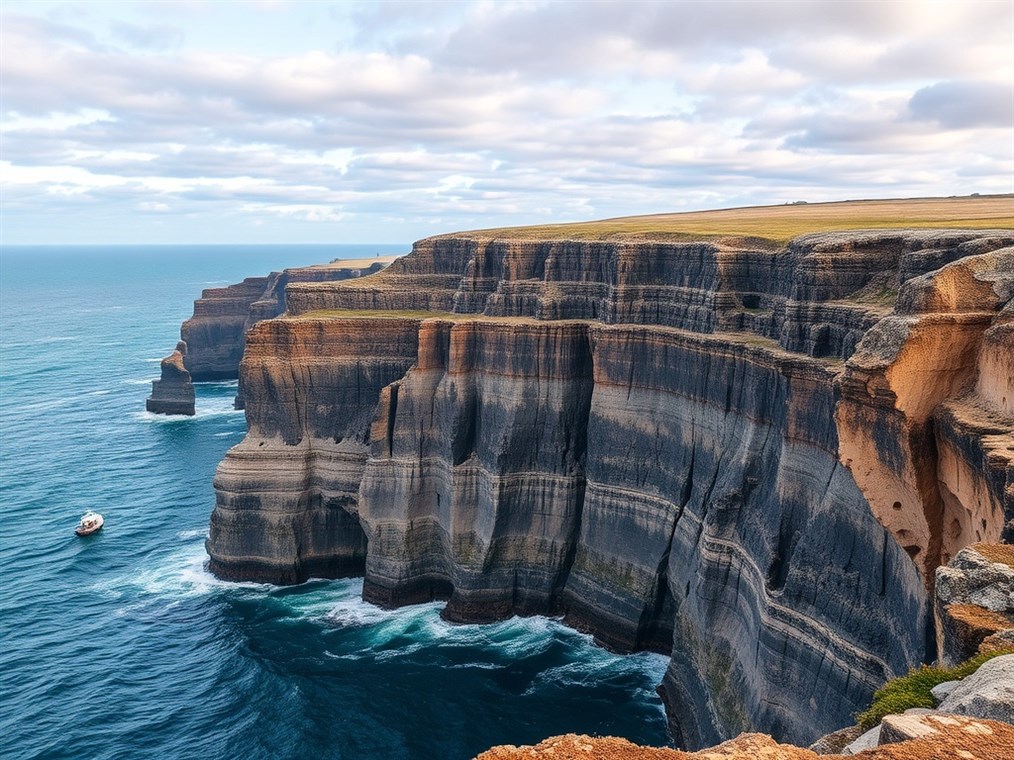
Decoding Sea Cliffs: What These Coastal Giants Are Really Made Of
FactsDecoding Sea Cliffs: What These Coastal Giants Are Really Made Of
Ever stood at the edge of a sea cliff, gazing out at the ocean and wondering what exactly you’re standing on? These dramatic coastal features are more than just pretty views; they’re geological records etched by time and the relentless power of the sea. But what are they made of, really? It’s a surprisingly complex question, and the answer changes depending on where you are in the world.
At their heart, sea cliffs are built from rock, plain and simple. The type of rock, though, makes all the difference. Think of it like building a house – you can use brick, wood, or stone, and each material gives you a different result. With sea cliffs, the rock determines how the cliff looks, how stable it is, and how it stands up to the constant battering from the ocean.
So, what are the usual suspects? Sedimentary rocks are common players. These are rocks formed from layers of sediment that have been compacted over millions of years. Sandstone cliffs, made from cemented sand grains, can be incredibly sturdy, forming those impressive, sheer drops you sometimes see. Limestone, often formed from the remains of ancient sea creatures, is a different story. It’s vulnerable to acidic rainwater and seawater, which slowly dissolves it, creating some seriously cool, almost otherworldly erosion patterns. Then you have chalk, a type of limestone. Remember the White Cliffs of Dover? That’s chalk in action – soft, porous, and undeniably striking. Shale, on the other hand, is the underachiever of the sedimentary world. Formed from compressed mud, it’s less resistant and tends to form gentler, less dramatic slopes.
Igneous rocks, born from fire and fury deep within the Earth, are another key ingredient. Granite, that tough, speckled stone, is a real powerhouse. It forms rugged, vertical cliffs that can take a pounding. Basalt, a dark, volcanic rock, also creates steep cliffs, often with these amazing geometric columns that look like they were carved by giants.
Metamorphic rocks, the rebels of the rock world, are rocks that have been transformed by intense heat and pressure. Gneiss and schist, with their distinctive banded patterns, can be pretty tough customers, but it really depends on what they’re made of and how they’re structured.
But it’s not just about the rock. The ocean is a sculptor, constantly shaping and reshaping the coastline. Waves are the primary tool, eroding cliffs through brute force. Hydraulic action is like the ocean giving the cliff a wedgie, forcing air into cracks and fissures, weakening the rock from the inside out. Abrasion is like a constant sandblasting, with waves hurling sand and pebbles against the cliff face. And corrosion? That’s the ocean slowly dissolving the rock, especially limestone and chalk.
Weathering also plays a crucial role. Freeze-thaw is a classic example: water gets into cracks, freezes, expands, and eventually splits the rock apart. Salt weathering is similar, with salt crystals growing in pores and cracks, exerting pressure and causing the rock to crumble. And even plants and animals get in on the act, with roots growing into cracks and marine organisms boring into the rock.
Of course, there’s more to the story. Geological structures like faults and folds create weak points that erosion can exploit. The climate, the tides, even changes in sea level all have an impact. And let’s not forget about us humans. Coastal development, seawalls, and other activities can really mess with the natural processes and affect how stable a cliff is.
Sea cliffs are living, breathing things, constantly changing. They’re not static monuments; they’re dynamic landscapes. Erosion is always at work, causing cliffs to retreat, sometimes at alarming rates. The debris that falls from the cliff can form a protective barrier at the base, or it can be broken down by the waves to create a beach. It’s a constant cycle of destruction and creation.
So, the next time you’re standing on a sea cliff, take a moment to appreciate the incredible forces that have shaped it. It’s a story written in stone, a testament to the power of nature, and a reminder of the ever-changing world around us. Understanding what these coastal giants are made of is key to protecting our coastlines, keeping our communities safe, and truly appreciating the raw beauty of our planet.
You may also like
Disclaimer
Categories
- Climate & Climate Zones
- Data & Analysis
- Earth Science
- Energy & Resources
- Facts
- General Knowledge & Education
- Geology & Landform
- Hiking & Activities
- Historical Aspects
- Human Impact
- Modeling & Prediction
- Natural Environments
- Outdoor Gear
- Polar & Ice Regions
- Regional Specifics
- Review
- Safety & Hazards
- Software & Programming
- Space & Navigation
- Storage
- Water Bodies
- Weather & Forecasts
- Wildlife & Biology
New Posts
- Diving Deep into Tangerine: More Than Just a Sunny Locale
- Jamaica Backpack Daypack Pockets Shopping – Review
- TEOYETTSF Climbing Backpack Multifunction Military – Buying Guide
- The Curious Case of Cavendish’s Classroom: Where Did This Science Star Study?
- Dragon Backpack Insulated Shoulder Daypack – Buying Guide
- ROCKY Hi-Wire Western Boots: A Rugged Review After a Month on the Ranch
- Vertical Curbs: More Than Just Concrete Barriers
- Regatta Modern Mens Amble Boots – Honest Review
- YMGSCC Microfiber Leather Sandals: Beach to Boardwalk, Did They Hold Up?
- Tangier: More Than Just a Backdrop in “Tangerine”
- DJUETRUI Water Shoes: Dive In or Doggy Paddle? A Hands-On Review
- Barefoot Yellow Pattern Hiking 12women – Is It Worth Buying?
- Koa Trees: How Fast Do These Hawaiian Giants Really Grow?
- DDTKLSNV Bucket Hat: Is This Packable Sun Shield Worth the Hype?